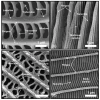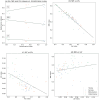Nanostructural Influence on Optical and Thermal Properties of Butterfly Wing Scales Across Forest Vertical Strata
- PMID: 39459791
- PMCID: PMC11509712
- DOI: 10.3390/ma17205084
Nanostructural Influence on Optical and Thermal Properties of Butterfly Wing Scales Across Forest Vertical Strata
Abstract
Butterfly wing scales feature complex nanostructures that influence wing coloration and various mechanical and optical properties. This configuration plays a key role in ecological interactions, flight conditions, and thermoregulation, facilitated by interactions with environmental electromagnetic energy. In tropical forests, butterflies occupy distinct vertical habitats, experiencing significant light and temperature variations. While wing nanostructures have been widely studied, their variation across different vertical flight preferences remains underexplored. This study investigates the wing nanostructures of 12 tropical butterfly species from the Nymphalidae family, focusing on their optical, morphological, and thermal properties across different forest strata. We analyzed the optical response through diffuse reflectance in the UV, Vis, and NIR ranges, correlating these findings with nanostructural configuration and thermal stability using thermogravimetric analysis (TGA). Our results reveal a significant correlation between flight stratification and wing optical responses, alongside distinct nanostructural features within each stratum. This study demonstrates the variability in butterfly wing nanostructures along the vertical stratification of the forest to cope with environmental conditions, raising new questions for future research on eco-evolutionary flight and thermal adaptations. Additionally, this underscores the importance of understanding how these structural adaptations influence butterfly interactions with their environment and their evolutionary success across different forest strata.
Keywords: diffuse reflectance; flight preference; spectroscopy; thermogravimetry; tropical forest; vertical stratification.
Conflict of interest statement
The authors declare no conflicts of interest.
Figures








References
-
- Mouchet S., Vukusic P. Advances in Insect Physiology. Volume 54. Academic Press Inc.; Cambridge, MA, USA: 2018. Structural Colours in Lepidopteran Scales; pp. 1–53. - DOI
-
- Fang Y., Sun G., Bi Y., Zhi H. Multiple-dimensional micro/nano structural models for hydrophobicity of butterfly wing surfaces and coupling mechanism. Sci. Bull. 2015;60:256–263. doi: 10.1007/s11434-014-0653-3. - DOI
-
- Haché A., Allogho G.-G. Opto-thermal modulation in biological photonic crystals. Opt. Commun. 2011;284:1656–1660. doi: 10.1016/j.optcom.2010.11.043. - DOI
LinkOut - more resources
Full Text Sources
Miscellaneous

